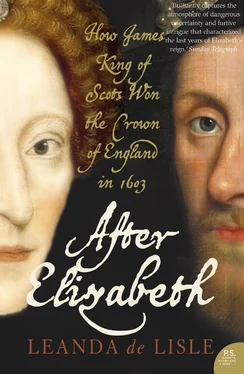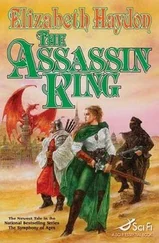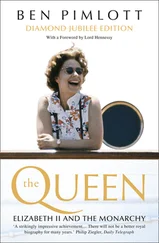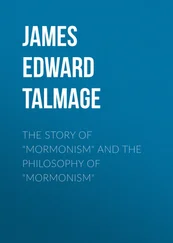Harington arrived at court having completed, on 18 December, his Tract on the Succession to the Crown – a subject on which the pulse of the nation was now said to ‘beat extremely’ but which was strictly forbidden. As Harington had recorded in his tract, Elizabeth had ‘utterly suppressed the talk of an heir apparent’ in the year of his birth, 1561, ‘saying she would not have her winding sheet set up before her face’. Her concern, he explained, was ‘that if she should allow and permit men to examine, discuss and publish whose was the best title after her, some would be ready to affirm that title to be good afore hers’. 8
Forty years earlier there had been those who had claimed that Elizabeth’s Catholic cousin, Mary, Queen of Scots, had a superior claim to the English throne; others that it belonged to her Protestant cousin Catherine Grey. Both claimants had since died: Catherine in a country house prison in 1568, Mary on the executioner’s block in 1587. But their sons, James VI of Scotland and Lord Beauchamp had succeeded them as rivals to her throne, together with more recent candidates such as James’s cousin, Arbella Stuart, and the Infanta Isabella of Spain. The dangers to Elizabeth were such that the publication of any discussion of the succession had been declared an act of treason by Parliament only the previous winter. Her advancing age meant, however, that an heir would soon have to be chosen, if not by her, then by others.
Harington had dedicated his tract to his preferred choice, James VI, the Protestant son of Mary, Queen of Scots. As the senior descendant of Henry VIII’s elder sister, Margaret, and her first husband, James IV, he was Elizabeth’s heir by the usual dynastic rules of primogeniture, but James was far from being the straightforward choice that this suggests.
The Stuart line of the Kings of Scots was barred from the succession under the will of Henry VIII, which was backed by Act of Parliament. James was also personally excluded under a law dating back to the reign of Edward III precluding those born outside ‘the allegiance of the realm of England’. His hopes rested on the fact that the claims of his rivals were equally problematic. Elizabeth had declared Catherine Grey’s son, Lord Beauchamp, illegitimate, and, as men had delved ever deeper into the complex question of the right to the throne, the numbers of potential heirs had proliferated. By 1600 the sometime writer, lawyer and spy Thomas Wilson had counted ‘twelve competitors that gape for the death of that good old princess, the now queen’. 9 Spain, France and the Pope all had their preferred candidates while the English were divided in their choice by religious belief and contesting ambitions.
Courtiers feared that the price of Elizabeth’s security during her life would be civil war and foreign invasion on her death – but the future was also replete with possibilities. A new monarch drawn from a weak field would need to acquire widespread support to secure their position against their rivals. That meant opening up the royal purse: there would be gifts of land, office and title. Harington’s tract was a private gift to James made in the hope of future favour. The gamble was to invest in the winning candidate – for as Thomas Wilson observed ‘this crown is not likely to fall for want of heads that claim to wear it, but upon whose head it will fall is by many doubted’. 10
The Palace of Whitehall, built by Cardinal Wolsey and extended by Henry VIII, sprawled on either side of King Street, the road linking Westminster and Charing Cross. On the western side were the buildings designed for recreation: four covered tennis courts, two bowling alleys, a cockpit and a gallery for viewing tournaments in the great tiltyard. Up to 12,000 spectators would come to watch Elizabeth’s knights take part in the annual November jousts held to celebrate her accession. When the jousts were over the contestants’ shields were hung in a gallery, where, that summer, the visiting German Duke of Stettin-Pomerania had been directed to admire the insignia of Elizabeth’s last great favourite, Robert Devereux, the second Earl of Essex. He had broken fifty-seven lances in the course of fighting fifteen challengers during the Accession Tilts of 1594. There was, however, much more to Essex than his prowess at the tilt. He had represented the aspirations of Harington’s generation, born after Elizabeth became Queen and kept from office by her stifling conservatism.
Elizabeth is still remembered as the Queen who defied the Armada in 1588, and the figure of Gloriana as encapsulated in Edmund Spenser’s The Faerie Queene the following year. But as one court servant warned, this was to see her ‘like a painted face without a shadow to give it life’ 11 . Elizabeth had reached the apogee of her reign in the 1580s. Thereafter came a decline that lasted longer than the reigns of her siblings, Mary I and Edward VI, put together. Her victory over the Armada was tarnished by the costs of the continuing war with Spain and the woman behind the divine image had grown old. To Essex’s vast following of young courtiers Elizabeth was a dithering old woman, dominated by her Treasurer Lord Burghley and his corrupt son, Sir Robert Cecil. Her motto ‘Semper Eadem’ (I never change), once perceived as a promise of stability, came to be taken as a challenge.
When Burghley died in August 1598, Essex hoped to become the new force in Elizabeth’s government but within weeks a long simmering rebellion in Ireland had turned into a war of liberation. Essex, as Elizabeth’s most experienced commander, was made Lord Deputy of Ireland and sent to confront the rebel leader, Hugh O’Neill, Earl of Tyrone. Instead, in September 1599, in defiance of royal orders, Essex arranged a truce and returned to court. Elizabeth was furious and as Essex fell into disgrace he turned his hopes to finding favour with the candidate he hoped to succeed her. In February 1601 he led 300 soldiers and courtiers in a palace revolt to force her to name James VI of Scotland her heir and overthrow Robert Cecil together with his principal allies, Henry Brooke, Lord Cobham and Sir Walter Ralegh. The revolt quickly failed and the Earl was executed, but Essex remained a popular figure in national memory. Stettin’s journal records that ballads dedicated to Essex were being ‘sung and played on musical instruments all over the country, even in our presence at the royal court though his memory is condemned as that of a man having committed high treason’. 12 They mourned England’s ‘jewel … The valiant knight of chivalry’, destroyed, it was said, by the malevolence of the Cecil faction.
Brave honour graced him still,Gallantly, gallantly,He ne’er did deed of ill,Well it is known But Envy, that foul fiend,Whose malice ne’er did endHath brought true virtue’s friendUnto his thrall . 13
Beneath the smiles of the courtiers as they played cards that Christmas lay the deep bitterness of old enemies; those who had admired Essex and those who had rejoiced in his downfall.
The gallery above the tiltyard where Essex had jousted was linked to the second group of buildings through a gatehouse over King Street. Here, in the Privy Gardens, thirty-four mythical beasts sat on thirty-four brightly coloured poles overlooking the low-railed pathways. The buildings had a similarly fairy-tale quality. They were decorated in elaborate paintwork, the Great Hall in chequerwork and the Privy Gallery in black and white grotesques. The theme of these distorted animal, plant and human forms extended into the interior where they were highlighted with gold on the wood pillars and panelling. The visiting Duke of Stettin thought the ceilings rather low and the rooms gloomy. Elizabeth’s bedroom, which overlooked the Thames ‘was very dark’ with ‘but little air’. Nearby in Elizabeth’s cabinet, where she wrote her letters, Stettin observed a marvellous silver inkstand and ‘also a Latin prayer book that the queen had written nicely with her own hand, and, in a beautiful preface, had dedicated to her father’. 14
Читать дальше












